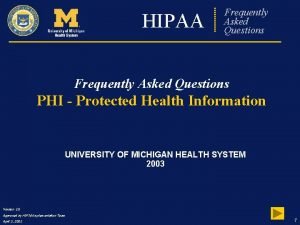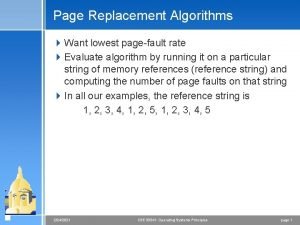FREQUENTLY ASKED QUESTIONS Frequently Asked Questions Why is






- Slides: 6

FREQUENTLY ASKED QUESTIONS

Frequently Asked Questions • Why is it important to understand the mechanisms of inflammation in joint diseases? • Is joint pain always related to joint destruction? • In the treatment of osteoarthritis, when is the addition of antidepressants reasonable? 2

Why is it important to understand the mechanisms of inflammation in joint diseases? Pain Treatment Options Damaged joint tissue Inflammatory chemical mediators Changed responsiveness of nociceptors (peripheral sensitization) • • • Brain Acetaminophen n. NSAIDs/coxibs Opioids Local anesthetics/ channel blockers Intra-articular corticosteroid/ hyalurinate injections Changed responsiveness of neurons in CNS (central sensitization) Nociceptive afferent fiber Spinal cord CNS = central nervous system; coxib = COX-2 inhibitor; ns. NSAID = non-specific non-steroidal anti-inflammatory drug Hochberg MC et al. Arthritis Care Res (Hoboken) 2012; 64(4): 465 -74; Scholz J et al. Nat Neurosci 2002; 5(Suppl): 1062 -7.

Why is it important to understand the mechanisms of inflammation in joint diseases? • Chronic joint pain due to arthritis is frequently inflammatory in nature • Inflammation is involved in the pathogenesis of both mechanical and inflammatory joint pain, such as osteoarthritis and rheumatoid arthritis • Understanding the pathophysiology of the pain can help guide treatment selection Firestein GS. In: Firestein GS et al (eds). Kelley’s Textbook of Rheumatology. Vol 2, 8 th ed. Saunders Elsevier; Philadelphia, PA: 2008; O’Dell JR. In: Goldman L, Ausiello D (eds). Cecil Medicine. 23 rd ed. Saunders Elsevier; Philadelphia, PA: 2007.

Is joint pain always related to joint destruction? • Joint pain may be due to soft tissue injury (as in tendinitis and bursitis), in which the soft tissue near the joint is inflamed, rather than the joint itself • Thus, in these cases, the pain felt by the patient is not necessarily associated with joint destruction as seen using imaging modalities University of Washington Medicine. Bursitis, Tendinitis, and Other Soft Tissue Rheumatic Syndromes. Available at: http: //www. orthop. washington. edu/? q=patient-care/articles/arthritis/bursitis-tendinitis-and-other-soft-tissue-rheumaticsyndromes. html. Accessed: September 1, 2013.

In the treatment of osteoarthritis, when is the addition of antidepressants reasonable? • Some osteoarthritis patients may use terms such as “burning” or “numbness” to describe their pain – These descriptors suggest a neuropathic component • Non-traditional analgesics (e. g. , α 2δ ligands, TCAs, SNRIs) may be useful for treating this component – Further studies are needed to clarify the role of these drugs in osteoarthritis SNRI = serotonin-norepinephrine reuptake inhibitor; TCA = tricyclic antidepressant Mease PJ et al. J Rheumatol 2011; 38(8): 1546 -51. OA











